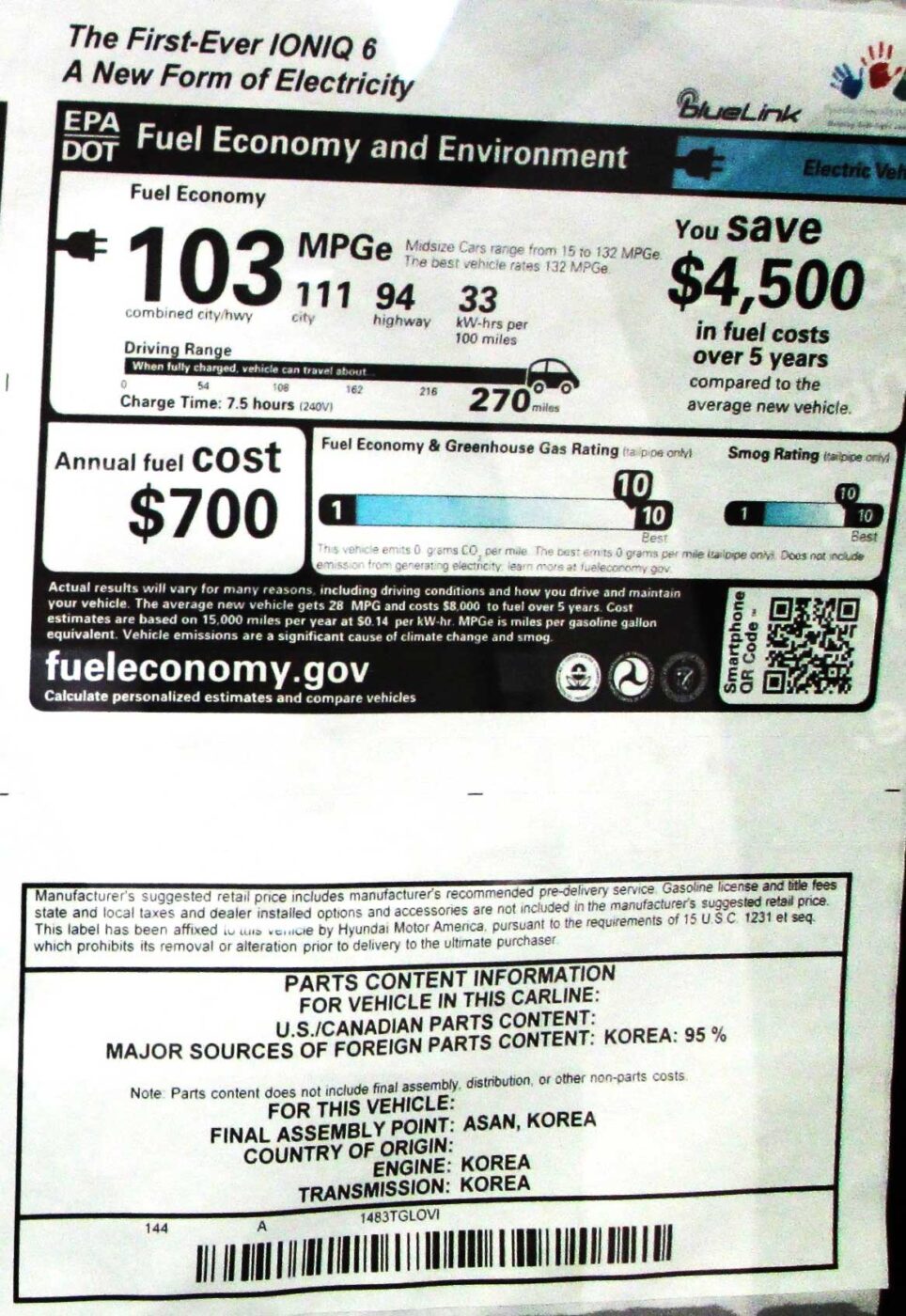My Story
I’m Susan’s brother Scott. I’ve had about 8 gasoline cars in my life before discovering that a hybrid would allow me to have large vehicle to carry my family while improving the gas mileage. I bought a 2008 Ford Escape Hybrid. I liked that it got good mileage, recaptured otherwise wasted energy during braking, and accelerated and idled very quietly. Next, I learned about rechargeable hybrids and bought a Chevy Volt. It still used gasoline, but could also plug in at night on a regular 110v plug to run electric-only for the first 40 miles or so each day. But I’ve been most happy with my latest, all-electric vehicle. No more oil changes or stops at the gas station! I am able to charge in my garage at night and do that for 98% of fueling. Only on long trips do I need to recharge on the road and that happens in about 20 minutes. Not going back.
Although you may read that there is an estimated 10 year battery life based on some readings, the issue may be much more nuanced and interesting. Batteries degrade about 1.8% per year on average according to what I have read and this article https://www.geotab.com/uk/press-release/2024-battery-degradation/. My fully electric car has lost 23 miles of range(23/224=10.3%) in 6 years so seems about on that path too. I usually get 15 years or so out of a car so I don’t believe I will ever replace mine and it will still have 160+ miles of range at that point. It charges up in about 25 minutes at a fast charger or 5 hours overnight at home. Given most commutes are about 40 miles, for many people the change in range is likely unnoticed during the life of the car.
Your Choices
| Action Choices and Links | Cost | Notes |
| Evaluate Purchasing an Electric Car | $$,$$$ | Great for heavy local travel |
| Charge Your Electric Car at Home OR Where You Work OR at a Charging Station | $ | Much reduced transport and maintenance costs after purchase |
| Consider a Hybrid Electric Car | $$,$$$ | May be useful for heavy long-distance travel |
| Evaluate Purchasing an E-Bike | $,$$$ | Great for local travel |
| Charge Your E-Bike at Home | $ | Useful even when no driveway or garage |
Evaluate Purchasing an Electric Car
Benefits include:
Charge Cheaply, Potentially at Home: If you are tired of high and increasing car gas bills, an electric vehicle can be charged at home, in a driveway or garage, and you can choose the cheapest time to charge. Fuel costs for an EV are typically half that of a hybrid-gas-electric, while hybrid cars are half that of a regular gas car (from www.fueldeconomy.gov for 2023-24 cars)! An EV charge estimate is $5 at home, or $0-20 at a public charge station. If you cannot charge at home, see the next section.
Enjoy Less Maintenance: EV cars are grossly simpler and require less maintenance compared to a traditional motor engine. No motor means no oil changes; there is also no fuel tank or no transmission. MotorWeek (N.D.) estimates you will still need to rotate tires every 7,500 miles, and should also have other components checked including the 12-volt battery, brakes and suspension.
Generate Less Pollution and Greenhouse Gases: EVs generate far less pollution and greenhouse gas emissions – with an energy impact on the order of 0.1 barrels/year. Electric vehicles are making strong improvements in driving range. As oil becomes harder to find, oil quality goes down while its processing price and pollution goes up. Renewable energy is regional and costs are reduced with time as technologies become more efficient.

Charge Your Electric Car at Home OR Where You Work OR at a Charging Station
The easiest and cheapest charging location is your home’s driveway or garage. You may also find charging stations wherever you are at https://afdc.energy.gov/fuels/electricity_locations.html. Charging stations range from the slowest (Level 1, a regular AC home outlet) to Level 2 (a 240 volt outlet), to the fastest Level 3 commercial charging station outlets. Level 3 charging companies (e.g., -ChargePoint+, Volta) retain website maps showing open charging slots. If your home has a driveway or garage, you can charge most cheaply at level 1, or with enhancement, at level 2 speeds.
| Charger Type & Charge Rate | Charger Plug Types | Charging Locations |
| Level 1 AC Charger Charging Rate: 5 miles per hour | Plug type: NACS or SAE J1772 Tesla uses NACS or J1772 adapter | Only used at home; requires no modifications to regular outlet (120 Volts AC).Charging Cheap option, at home electrical rates. |
| Level 2 AC Charger Charging Rate: 25 miles per hour Charging Time: 4 to 5 hours | Plug type: NACS or SAE J1772 Tesla uses NACS (or J1772 adapter) | Used at public charging station or at home with modification (240 Volts AC). Costs: free with parking lot entry or $1-2 per hour (estimated). |
| Level 3 DC Fast Charger Charging Rate: 100-300+ miles per 30 minutes Charging Time: 20 minutes to 1 hour | Plug type: Most common: NACS or CCS SAE J1772 Combo or CHAdeMO Tesla: NACS or adapter | Public only charging at slightly higher prices; available for distance travel. Example Charging Companies: Electrify America, EVgo and Tesla EVgo and Electrify America support NACS and CCS SAE J1772 adapters; Tesla supports NACS. |
The North American Charging Standard (NACS) adopted the Tesla Combo adapter, because this single charger works with all three levels.

Finding A Charging Station
The following website enables you to choose location, charger rate(s), and the plug type(s) you support:
Electric Vehicle Charging Station Locations. Alternative Fuels Data Center, U.S. Dept. of Energy. From: https://afdc.energy.gov/fuels/electricity_locations.html#/find/nearest?fuel=ELEC.

For much more information on Green Vehicles, see: https://www.epa.gov/greenvehicles; on charging, see: https://www.epa.gov/greenvehicles/plug-electric-vehicle-charging-details. The EPA’s Electric Vehicle Myths may answer additional questions at: https://www.epa.gov/greenvehicles/electric-vehicle-myths.
Consider a Hybrid Electric Car
The U.S. Dept of Energy (2023) indicates that an all-electric vehicle (or Battery-Electric Vehicle, BEV) can travel 150-400 miles before requiring a recharge. A plug-in hybrid electric vehicle (PHEV) can travel 20-40 miles, before reverting to its gasoline engine. A hybrid electric vehicle (HEV) charges its battery from operating its gas engine through peak efficiencies, not from plugging in.
Evaluate Purchasing an E-Bike
An energy-efficient bike for you and your pocket book, it can carry miniature dog (or supplies) and can be recharged at home.

These bikes have a positive impact on the pocket book and the environment, since they are cheaper and so energy efficient – vastly outperforming gas-guzzling cars. Benefits include:
- E-bike costs range between $1000-$4000
- Can be charged at home in 2-8 hours
- Can throttle to 20 mph (Class 1 with pedaling) and (Class 2 without pedaling) or can throttle to 28 mph (Class 3 with pedaling) (Seplavy & Lea, 2025)
- Does not need a license
- May run to 150 miles without pedaling or recharging
- Note: larger tire sizes and body weight affect battery life
Charge Your E-Bike at Home
E-bikes are easier to charge when your home does not have a garage or car port, making recharging an electric car at home out of the question. However, an e-bike could be feasible, since a bike is more maneuverable into an apartment or house. Also, the battery may be removed and recharged separately from the bike.
Avoid Fire Hazards
One concern (other than driving carefully to avoid accidents) is to avoid battery fires, which have been an issue. It is important to select a lithium-ion battery that is Certified to the UL 2849 standard (Seplavy & Lea, 2025). You can check at this cite for compliance: https://productiq.ulprospector.com/en/search?term=qgns. When not charging or on the bike, keep the battery in a plastic bag not touching other batteries.
For More Info: To learn more about e-bikes, see site: https://www.bicycling.com/bikes-gear/a22132137/best-electric-bikes/. This site talks about the different types of e-bikes, defines basic terminology, describes different offered features, and recommends 16+ bikes, providing statistics on each of them, such as weight, cost, power and features. This reputable site, offered by Bicycling, offers useful technical and scientific information, not just sales jargon high on superlatives and low on detail.
References
- DOE (2025) Electric Vehicle Charging Station Locations. Alternative Fuels Data Center, U.S. Dept. of Energy. From: https://afdc.energy.gov/fuels/electricity_locations.html#/find/nearest?fuel=ELEC, taken Oct 9, 2025.
- EPA (2024) Greenhouse Gas Emissions from a Typical Passenger Vehicle. United States Environmental Protection Agency. From: https://www.epa.gov/greenvehicles/greenhouse-gas-emissions-typical-passenger-vehicle.
- EPA (2025) Plug-in Electric Vehicle Charging: The Basics. January 15, 2025. Environmental Protection Agency. From: https://www.epa.gov/greenvehicles/plug-electric-vehicle-charging-basics
- MotorWeek (N.D.) Electric Vehicle Maintenance. MotorWeek. Episode 4005 , Episode 4017. From: https://motorweek.org/goss_garage/electric-vehicle-maintenance/, taken Oct 13 2025.
- T Seplavy, B Lea (2025) Overwhelmed by E-Bike Options? We Tested Dozens—These 16 Are Actually Worth It. Bicycle. Sep. 23, 2025. From: https://www.bicycling.com/bikes-gear/a22132137/best-electric-bikes/#the-three-classes-of-e-bikes
